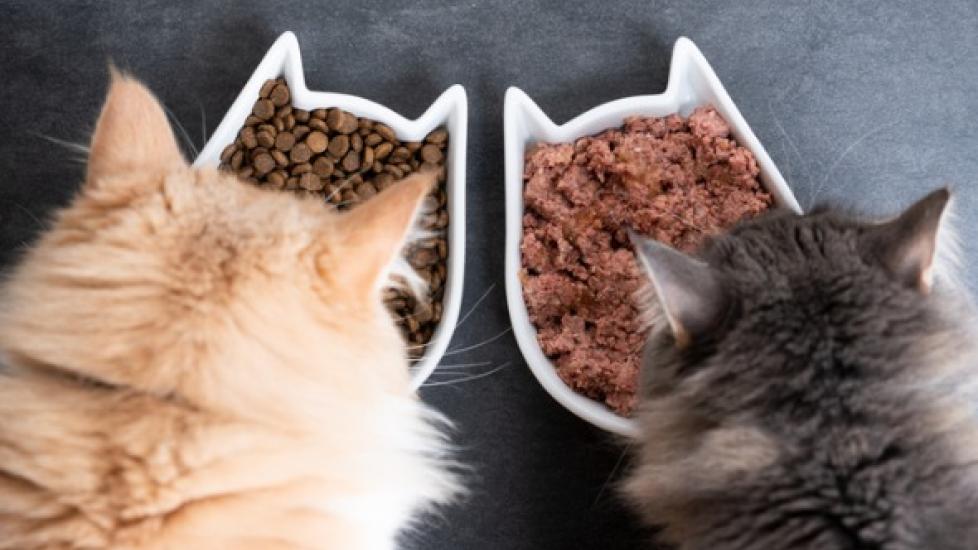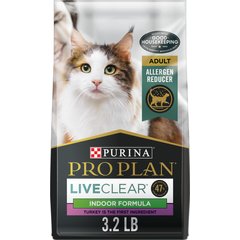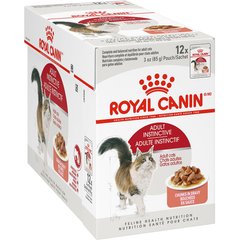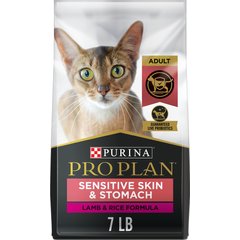Wet Cat Food vs. Dry Cat Food: Which Is Better?
A common question that veterinarians get asked is whether cats should eat canned or dry food.
The good news is that most commercial cat foods provide an excellent source of nutrition, whether it’s dry cat food or wet cat food. But finding the best food for your cat will depend on several factors, including:
-
Your cat’s weight
-
Your cat’s health and any health conditions present
-
Your budget
Whether to feed dry, canned, or a mixture of both is a decision that you and your veterinarian can make together to provide the best health for your cat. Here’s some insight on wet vs. dry cat food.
What Are the Main Differences Between Wet Cat Food and Dry Cat Food?
Here are a few big differences between wet cat food and dry cat food.
Moisture Levels
The main difference between dry and canned cat food is the amount of water that the food contains.
Dry cat food contains approximately 10% of water, and the other 90% consists of dry matter such as carbohydrates, fats and vitamins. Canned food contains much more water—approximately 70%—compared to dry matter.
This can be important to consider when choosing which to feed if your cat has certain health conditions that may benefit from more water intake.
Manufacturing Process
Given the higher moisture content in canned foods, these foods are typically made with fresh or frozen meats in combination with a protein source that comes from grains. The meats are blended with water, fats, and vitamins and placed in a can, where a heating process ensures that foodborne pathogens are destroyed.
Dry food is made by combining and then cooking meats, vitamins, minerals, and fats at a high temperature and pressure, which makes the starches more digestible. Fat may then be sprayed on the food to ensure that it’s palatable.
Nutrients
Dry cat food typically contains more carbohydrates than canned food. The protein and fat in canned vs. dry can vary based on the type of diet. Certain formulations of dry cat food may also contain probiotics.
Vet Recommended Cat Food
- Purina Pro Plan LIVECLEAR Adult Indoor Formula Dry Cat Food, 3.2-lb bag$18.78Chewy Price
- Hill's Science Diet Adult Multiple Benefit Chicken Recipe Dry Cat Food, 15.5-lb bag$63.99Chewy Price
- Royal Canin Feline Health Nutrition Adult Instinctive Chunks in Gravy Cat Food Pouch, 3-oz, case of 12$26.28Chewy Price
- Purina Pro Plan Adult Sensitive Skin & Stomach Lamb & Rice Formula Dry Cat Food, 7-lb bag$28.08Chewy Price
Should I Feed My Cat Dry or Wet Cat Food? Or Both?
Whether to feed your cat dry food, canned food, or a mixture of both depends on several factors. Here are some benefits and drawbacks of both types of food.
Canned Cat Food Benefits
The largest benefit of feeding a canned diet is the higher water content. Cats with certain health conditions that require a higher-than-normal water intake, such as kidney disease, diabetes, or lower urinary tract disease, may benefit from the additional water in these diets.
Canned food is also highly palatable, and some cats will eat a canned diet over a dry diet, particularly if they are picky eaters.
Canned Cat Food Drawbacks
Canned food is often more expensive than dry food, so this may play a role in your decision.
Once opened, canned food has a shelf-life of 24 hours and must be stored in the refrigerator. If your cat does not finish their wet food, it should be properly stored in the refrigerator or discarded. Leaving canned food out for longer than a few hours can run the risk of contamination and cause gastrointestinal upset.
Dry Cat Food Benefits
Dry cat food is less expensive than canned food, so people who are on a strict budget or those that feed community cats may choose this option.
Dry food also does not have to be stored in the refrigerator and can be left out much longer than can food. This is a good option if you free-feed your cats, but any portion not eaten by the end of the day should be discarded.
You can also use dry cat food in automatic feeders or in puzzle feeder toys.
Dry Cat Food Drawbacks
Studies have shown a correlation between obesity and feeding dry cat food. This could be because a lot of cats that eat dry food are often free-fed, and owners do not realize how much their cats are actually eating in a day.
It can also cause the opposite problem because it’s hard to notice that your cat is not eating when they are free-fed. The amount your cat eats in a day should be monitored or measured out for both reasons.
Older cats with dental disease or those who have had some of their teeth removed may also have a harder time chewing dry food.
Feeding Both Canned and Dry Cat Food
To balance the benefits and drawbacks of both options, you may choose to feed a combination of both. This may be particularly useful with cats who require a higher water intake but enjoy eating dry better than canned.
By either mixing them together or giving canned at one feeding time and dry at the other, you may be able to get the benefits of both diets.
If you are looking to mix wet cat food and dry cat food, talk with your veterinarian to find the best balance. Your veterinarian can help you calculate how much your cat should be eating and how to portion out the two food options.
Every cat is different, and the amount you feed a day will depend on the age of your cat, your cat’s current body condition, and the presence of any underlying diseases.
What Wet and Dry Cat Food Do Veterinarians Recommend?
Regardless of whether you choose to feed a dry or canned cat food, it is important to feed a well-balanced, commercial diet to ensure that your cat gets the vitamins and minerals they need.
Reputable brands such as Science Diet® and Royal Canin® have been quality-controlled and specially formulated to meet a cat’s nutritional requirements. Your veterinarian can give you more specific recommendations based on your cat’s health history.
Avoid feeding a home-cooked or homemade diet unless it is specially formulated by a veterinarian who is specialized in making these diets. If you don’t have help from a qualified vet, these diets can be deficient in vitamins and minerals such as taurine, which can cause heart disease in cats.
Involving your veterinarian in your decision of what to feed your cat can be very helpful in ensuring they get the most appropriate nutrition.
Here are some other things to consider.
AAFCO Approval
Basic minimum nutritional requirements for cats have been established by the Association of American Feed Control Officials (AAFCO). This is important because all pet foods that carry an “AAFCO statement“ or “AAFCO-approved nutritional guarantee” are considered to be nutritionally complete and well-balanced diets for your cat.
Ingredient List
It’s important to read the label on the back of the package to ensure that the main ingredients, which will be listed first, consist of meat and meat by-products. This is because cats are carnivores and require a high-protein diet that supplies the appropriate amount of essential amino acids and fatty acids.
Your Cat’s Particular Health Needs
The best cat food for your cat will be unique to their lifestyle and nutritional needs.
For example, if your kitten or cat is of normal weight and healthy, then a kitten or adult maintenance diet should be sufficient. If your cat is overweight, it may be best to look for a low-fat diet.
If your cat has a health condition, your veterinarian may prescribe a specific diet formulated for that disease. For example, kidney diets are recommended in most cats who develop kidney disease, or a urinary diet may be more appropriate in cats who have lower urinary tract disease.
Your Cat’s Preferences
At the end of the day, you may not have a choice in what type of diet you feed your cat. Some cats can be very picky and only eat dry or only eat wet food.
Featured image: iStock.com/Nils Jacobi




